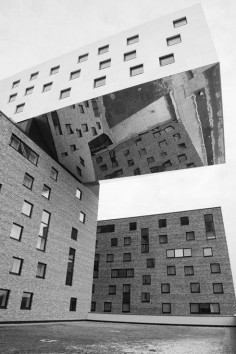NPS TCHOBAN VOSS
nhow hotel berlin
source: nps-tchoban-vossde
Bei einer Definition des eigenen Tuns hilft allenfalls der altgediente Funktionalismus mit seiner Forderung nach der Funktionserfüllung als vornehmster Aufgabe der Architektur weiter, sowie der etwas modischere Kontextualismus, der Architekten anhält, sich auf der Suche nach Entwurfsprämissen tunlichst in der Umgebung ihrer Bauprojekte umzusehen. Und vielleicht der römische Traktatschreiber Vitruv, der vor zweitausend Jahren die Dreieinigkeit utilitas, firmitas und venustas als konstituierende Grundlage allen Bauens entdeckte. Denn zunächst einmal muss der Bauherr zufrieden sein. Zufrieden ist er laut Vitruv, wenn die Funktion (utilitas) stimmt und wenn die Wirtschaftlichkeit gegeben ist, die wiederum voraussetzt, dass die Konstruktion (firmitas) stimmt, dass also solide gebaut wurde. Über den Kontext, den Standort – den Genius loci – machen sich die Architekten darüber hinaus Gedanken, wenn es gilt, ein Gebäude zu strukturieren und zu gestalten, was wiederum die Wohlgestalt (venustas) einschließt.
Die in allen Epochen existente und heute besonders bei der populären und spektakulären internationalen Stararchitektur verbreitete Haltung, architektonisches Entwerfen mit der Gestaltfindung zu beginnen, also zunächst nach einer signifikanten, möglichst außergewöhnlichen Form zu suchen und dieser alles andere unterzuordnen, ist ihnen fremd. Raumbildung und sinnliche Wahrnehmung der das Ambiente formenden architektonischen Elemente sind ihnen von Anbeginn wichtiger gewesen als die als vordergründig empfundenen modischen Effekte. Das Streben nach Nutzwert, Solidität und Werthaltigkeit hat sicher seine Gründe auch im Werdegang des Büros, dessen Ursprünge in die frühen dreißiger Jahre zurückreichen.
.
.
.
.
.
.
.
source: nps-tchoban-vossde
When defining one’s own actions, at most the time-honored functionalisms helps along with its requirement for fulfilling the function as the most noble task of architecture as well as the slightly more modern contextualism which requires from the architects to look around, if possible, in the environment of their building projects when looking for design premises. And perhaps the Roman treatise writer, Vitruv, who detected trinity utilitas, firmitas and venustas, some two thousand years ago as the constituting basis of all construction; because, first off all, the principal must be satisfied. He is satisfied according to Vitruv, if function (utilitas) is correct and if the efficiency is available which in turn requires that construction (firmitas) is correct which means that the building was constructed solidly.
Beyond this, the architects think over the context, the site – the genius loci – when it is necessary to structure and design a building which, in turn, includes noble appearance (venustas).
The attitude existent in all epochs and today is particular widespread in the popular and spectacular international star architecture to start the architectural design by finding the form , which means first of all to look for a significant and, if possible, extraordinary one and to subordinate all other aspects to this, is foreign to them. Understanding of space and sensory perception of the architectural elements forming the ambient, were more important to them right from the beginning than the modish effects felt as superficially. Striving for the value in use, solidity and intrinsic value is surely established also in the development of the office, the origins of which reach far back into the early Thirties of the last century.
.
.
.
.
.
.
.
source:dezeencom
Extreme cantilever alert! A four-storey block with a mirrored underside juts out from the top of a Berlin hotel, 25 metres above the ground (photos by Roland Halbe).
The huge cantilever comprises the upper floors of the eleven-storey NHow Hotel, which was designed by German architects NPS Tchoban Voss.
The end of the cantilever is fully glazed whilst the underside is clad in polished aluminium, creating a mirror that reflects the hotel roof below.
Part of the NHow chain, the 310-room hotel contains music facilities that include a ballroom and a sound studio.
Another Berlin cantilever by NPS Tchoban Voss was also featured on Dezeen this week – see our earlier story.


